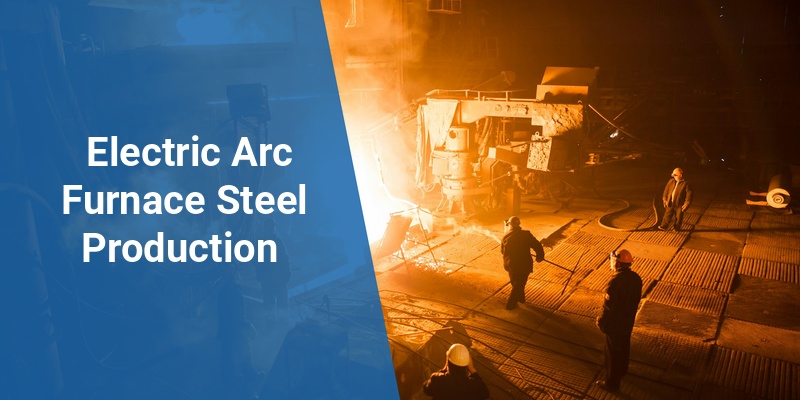The production of steel using Electric Arc Furnaces (EAF) has revolutionized the steel industry by enabling a more sustainable and cost-effective method of manufacturing. This process uses electrical energy to melt scrap steel or direct reduced iron, providing flexibility and efficiency unmatched by traditional blast furnace methods. EAF steel production is vital for addressing environmental concerns while meeting modern industrial demands.
| Aspect | Description |
|---|---|
| Primary Input | Scrap steel, Direct Reduced Iron (DRI) |
| Energy Source | Electricity (Arc Heating) |
| Typical Uses | Construction, Automotive, Appliances |
| Environmental Impact | Lower CO2 emissions compared to blast furnaces |
| Production Flexibility | High (can adjust to varying scrap quality) |
How Electric Arc Furnace Steel Production Works
The electric arc furnace utilizes high-current electric arcs to melt steel scrap or iron feedstock efficiently. Electrodes made of graphite create an arc that generates intense heat, reaching temperatures around 3,000°C (5,432°F). This method allows steelmakers to rapidly recycle scrap into new steel products.
The process typically involves:
- Charging the furnace with scrap or DRI.
- Applying electric arcs via electrodes to melt the metal.
- Refining the molten steel by adding alloying elements or adjusting chemical composition.
- Pouring the liquid steel into molds or casting machines.
Unlike blast furnaces, which require coke and iron ore, EAF relies predominantly on recycled material, making it more adaptable and energy-efficient.
The Advantages of Using Electric Arc Furnaces in Steelmaking
Electric Arc Furnace technology provides several key benefits that enhance steel production feasibility and sustainability.
- Environmental Benefits: EAFs have a significantly lower carbon footprint, producing up to 75% less CO2 emissions compared to traditional blast furnaces.
- Energy Efficiency: The ability to use electricity allows for cleaner energy sources integration, including renewables.
- Material Flexibility: EAFs can use a wide range of scrap metals, reducing raw material costs and waste.
- Shorter Production Cycles: Faster melting and refining result in quicker turnaround and responsiveness to market demand.
- Lower Capital Costs: Building and operating EAF facilities generally require less upfront investment than integrated steel plants.
Primary Raw Materials Used in Electric Arc Furnace Steel Production
The main feedstocks for EAF steel manufacturing are:
- Recycled Steel Scrap: The most common and cost-effective material; categorized by type and quality (e.g., shredded scrap, heavy melting scrap).
- Direct Reduced Iron (DRI): Used when scrap supply is insufficient or to improve steel purity. DRI is iron ore reduced using natural gas or hydrogen instead of coke.
- Alloying Elements: Elements like manganese, nickel, chromium are added to achieve specific steel grades needed for various applications.
Challenges in Electric Arc Furnace Steelmaking
Despite clear advantages, EAF steel production faces certain challenges:
Call 888-906-9139 for Free Local HVAC Quotes – No Obligation, Just Savings!
- Scrap Quality Variability: Scrap composition inconsistencies can affect the final steel quality and process efficiency.
- Electricity Cost Volatility: Since EAFs rely heavily on electrical energy, fluctuations in energy prices can impact profitability.
- Emissions Control: Though cleaner than blast furnaces, EAFs still produce dust, CO, and other emissions requiring stringent control.
- Technological Upgrades: Constant innovation is needed to maintain efficiency, such as advancements in electrode durability and furnace automation.
Economic Impact and Industry Trends in EAF Steel Production
The EAF segment is expanding rapidly as global steel demand evolves toward sustainable practices. Current industry trends include:
- Growth in Scrap Recycling: Increased recycling rates reduce dependence on raw iron ore and contribute to circular economy goals.
- Electrification and Green Steel Initiatives: Integration of renewable electricity and hydrogen-based reduction methods are shaping next-generation EAF processes.
- Geographic Shift in Production: EAF plants are more prevalent in regions with abundant scrap supply and affordable electricity, such as North America and Europe.
- Diversification of Product Lines: EAF steelmakers are expanding into specialty steels for automotive, construction, and appliance industries.
Environmental Considerations in Electric Arc Furnace Steelmaking
EAF steel production is considered one of the greenest methods in the steel industry. Key environmental aspects include:
- Reduced Carbon Emissions: Less fossil fuel consumption compared to blast furnaces means much lower greenhouse gas emissions.
- Energy Use Efficiency: Energy consumption per ton of steel is lower, especially when electricity comes from renewable sources.
- Waste Management: Slag byproducts are often recycled into construction materials or road base, minimizing landfill use.
- Pollution Control: Modern EAF plants incorporate filtration systems that significantly limit particulate emissions and hazardous gases.
Applications of Electric Arc Furnace Steel
Steel produced via Electric Arc Furnaces serves numerous sectors due to its versatility and quality:
- Construction Industry: Structural beams, rebar, and metal frameworks predominantly use EAF steel for its cost efficiency and strength.
- Automotive Manufacturing: Lightweight alloys and high-strength steels from EAFs enable safer and more fuel-efficient vehicles.
- Appliance Production: Durable and corrosion-resistant EAF steel grades are common in household appliances like refrigerators and washing machines.
- Packaging and Infrastructure: EAF steel is also essential in pipeline construction, bridges, and packaging materials.
Future Outlook for Electric Arc Furnace Steel Technology
The future of steel manufacturing increasingly leans on EAF technology advancement. Innovations anticipated include:
- Green Hydrogen Use: Complementing electricity with hydrogen reduction to achieve near-zero carbon emissions.
- Digitalization and Automation: Artificial intelligence and robotics will improve furnace operation efficiency, scrap sorting, and quality controls.
- Energy Source Diversification: Integration of solar, wind, and other renewables to stabilize energy supply and reduce operational costs.
- Enhanced Material Recycling: Development of advanced scrap processing to improve feedstock quality and sustainability.
These trends position EAF steel production as a crucial pillar in meeting global steel demand while aligning with environmental goals.
